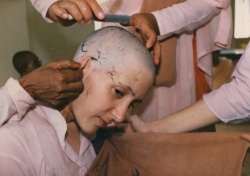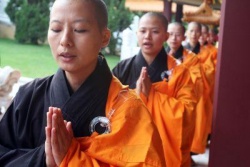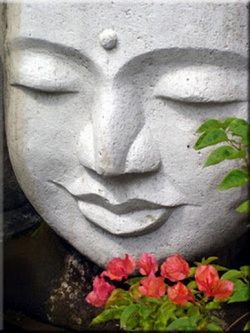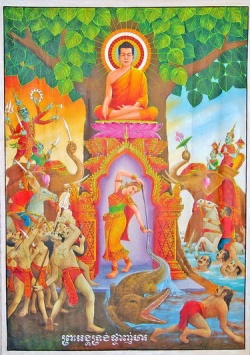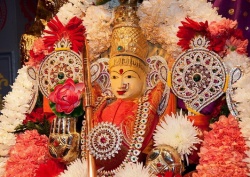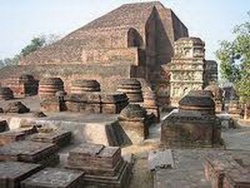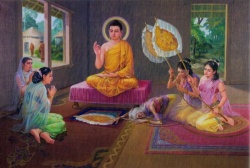The Participation of Women in the Renunciate Life
Bhikkhu Sujato
It was a time of deep magic. How could anyone ever forget it? The ground had been consecrated, chanted over in ancient Pali with all due solemnity and ceremony. For weeks I had prepared, sewing and dying robes, learning the chanting. All these things aided the most important preparation, the readiness of the heart. Finally I awoke on the day itself and shaved my head freshly, so that I would be as bald as a new-born baby. It was the day of my higher ordination.
The ceremony had the dignified simplicity typical of the Thai forest tradition. My mother was present to offer my robes and other requisites. The ordination itself was held in the Uposatha Hall of my upajjhāya (preceptor), Than Chao Kuhn Maha Amon, a senior disciple of Ajahn Chah, one of the great meditation masters of modern Thailand. A Sangha of more than ten bhikkhus gathered together in the centre of the hall, presided over by the upajjhaya. Observers were permitted in the hall, but had to remain outside of arm’s reach of the closely grouped monks.
The monks represented that most eminent spiritual community, the ordained heirs of the Buddha himself. More than that, they were my friends and my peers, men with whom I shared a lifestyle, an understanding, and an aspiration incomprehensible to most. Surrounded by these men I carefully repeated the words and phrases of the Pali exactly as had countless generations of bhikkhus before me. There was an interrogation, as the appointed delegates of the Sangha investigate whether the candidate is suitable or not. Then came the crucial part: the motion and three announcements. This is what we call a ‘Sanghakamma’, a formal ‘Act of the Sangha’, and can only be performed by a quorum of fully ordained bhikkhus or bhikkhunis. No single monastic can perform a Sanghakamma. Although the upajjhaya is sometimes spoken of as performing an ordination, strictly speaking the upajjhaya’s role is as facilitator and mentor. The Sanghakamma must be accomplished by the Sangha in complete consensus: if even one bhikkhu or bhikkhuni objects, the ordination is invalid.
The Pali word for ordination is upasampadā. Etymologically, upasampada suggests to ‘come close, join together, enter into’. It is commonly used in context of ‘entering’ into an attainment of jhana or samadhi, where it refers to a coalescence or communion. It carries the nuance of finality or completion, and might even be used of a sacrificial victim. In the context of ordination, it suggests ‘full acceptance’. One is no longer on the fringes, in a twilight zone. There is a deep solemnity to this feeling of being totally embraced within such a sanctified community.
In the institutional structures of Buddhism, the monastic Sangha is the inner circle. It forms the core group of those who have totally dedicated their lives to the Dhamma. As well as the spiritual opportunities it gives, this worldly prestige has its dangers. Like any elite, the Sangha may easily become corrupted and exclusivist. Various ways to prevent this are embodied within the structure of Dhamma-Vinaya. One of these ways is the lack of discrimination. Membership in the Sangha is not dependent on caste, race, wealth, or any of the other irrelevant standards that an unjust society often uses to oppress its people. The Sangha is open to anyone with the necessary commitment and dedication.
Except, of course, if you’re a woman.
One of the hot topics in the Buddhist world today is the issue of women’s ordination. We should all be familiar with the basic facts. The Buddha established a platform for ordination of female bhikkhunis, in all essential ways similar to the male bhikkhus. The bhikkhunis thrived in India for many centuries, and the order was established in Sri Lanka. According to records in the Chinese Tripitaka, the bhikkhuni lineage passed from Sri Lanka to China. While this might seem odd to us today, in fact the historical links between Sri Lanka and China are well known, as shown, for example, by the existence of a Sri Lankan Vinaya commentary in ancient Chinese. Subsequently, due to unknown reasons, the bhikkhuni tradition died out in Sri Lanka. It appears not to have been introduced to other countries such as Tibet and Thailand. But even today it flourishes in most of the countries whose primary Buddhist influence has come from China, such as Taiwan, Korea, and Vietnam.
Other countries have developed their own models for women’s ordination. There are many sincere women who have chosen the ten precept platform as a renunciate model, and who find it beneficial. They should be supported, respected, and encouraged in their choice.
It might be argued that monks are monks and nuns are nuns, and that most people are not even aware of the difference between a ten-precept nun and a bhikkhuni. But there is at least one group of people who are very aware of the difference: the bhikkhus. Upasampada is crucial to our sense of group identity, and we cannot help but see the ten precept nuns as a distinct group. Moreover, only the bhikkhuni form can claim authority from the Vinaya itself. The ten-precept novice or samaneri status was clearly intended as a stepping-stone to full ordination, not as an alternative career choice. Only bhikkhunis can perform Sanghakamma, and only bhikkhunis benefit from the complete and thorough training embodied in the Vinaya. The Buddha wanted female renunciates to live as bhikkhunis. It is no coincidence that, while women in all schools still await true equality, the opportunities and respect for nuns is invariably higher in those countries with a strong bhikkhuni tradition. The Vietnamese tradition even acknowledges a bhikkhuni in their traditional lineage of Sangha leaders (patriarchs?).
In recent years women from Theravādin and Tibetan traditions have sought bhikkhuni ordination from the Chinese lineage in order to reinstate the bhikkhuni lineage as originally set up by the Buddha. This movement has been controversial, and, while gaining significant support from the Sangha and the public, has not received the blessing of the majority of the male Sangha in the Theravādin and Tibetan traditions. But times are changing.
I am not very familiar with the Tibetan communities, so here I will speak only of the Theravādin response. Theravāda monks tend respond to this question by raising various ‘problems’ with bhikkhunis. Indeed, there was a book recently published in Thailand by a very prominent and relatively progressive monk under this very title: ‘Problems with Bhikkhunis’. These ‘problems’ turn out to be questions of details of ordination lineages, how to adapt Vinaya rules to modern times, and so on. They are, with not a single exception, trivialities of procedure and etiquette that have nothing to do with the essentials of spiritual life. No one has seriously questioned whether women are capable of living the holy life, whether they are capable of enlightenment, whether they are capable of illuminating this world like the moon freed from the clouds.
In my opinion this negative response has seriously skewed the debate. We waste our energies dogfighting over details and lose sight of the big picture. Of course it is true we must look at the details, too. While some of the bhikkhus who oppose bhikkhuni ordination do so out of fear and attachment to power, others do so out of a genuine concern for Vinaya. The bhikkhus’ rules are difficult to keep, and the bhikkhunis’ are even more so. But if, instead of complaining about ‘problems with bhikkhunis’ we were to celebrate the ‘opportunities of bhikkhunis’, we would see such things as mere management issues. I was recently privileged to attend the Global Buddhist Conference in Singapore and a Dhamma seminar in KL that featured several outstanding bhikkhunis as teachers. In fact, good though the monk speakers were, I cannot deny that the nuns were overall more impressive in their Dhamma presentations. It is appalling to think what opportunities we all lose when women’s spirituality is denied.
We do not refuse to ordain a man because we think he might break some rules – although there are countless monks who flagrantly ignore the rules every day. There is probably not a single monk alive today who has not broken some Vinaya rules. The Buddha expected that the Sangha should keep the most important rules, such as celibacy, absolutely. But with the other rules monks and nuns should try their best to keep them, and, in the event that a rule is broken, should carry out the appropriate penance.
There is an assumed duty in the bhikkhu’s Vinaya that, when there is a sincere and dedicated applicant, the Sangha should ordain him, then take care of his training and education so that he can keep the rules as best as possible. The same should apply to the bhikkhunis. I believe that the Sangha is obliged to assist in performing upasampada for women, and is neglecting its duty if it does not. If those bhikkhus who are sincere and careful in their approach to Vinaya shy away from the ‘bhikkhuni problem’ through fear of Vinaya violations, where else are the women to go but to those monks who are not sincere and careful in their Vinaya? And how are we, as bhikkhus, to criticize the bhikkhunis for not keeping the rules, when we have neglected our duty of care and support?
When we take a closer look at some of the so-called ‘problems’, we see that they are not insurmountable; there is room to move. For example, the origin story to the establishing of the bhikkhuni order lays down a rule that a bhikkhu may admonish a bhikkhuni, but a bhikkhuni may not admonish a bhikkhu. There are a number of textual problems with this event, but the most important fact is that it just feels wrong. It’s unfair, and obviously so. Unfortunately, the story for the laying down of this rule features the Buddha’s foster-mother in one of the key events in the history of the religion, and for this reason it became included in the standard telling of the story of the Buddha’s life, and is known by all Buddhists. But it does not stand comparison with one of the fundamentals expressed in the Vinaya itself: ‘It is thus that there is growth in the Blessed One’s following, that is, with mutual admonishment and mutual rehabilitation’. This beautiful principle has always struck me as self-evidently right. It’s Dhamma, and needs no explanation or justification. This principle has a prominent place in an important (sanghādisesa) rule, found in Vinayas of the Theravāda, Sarvāstivāda, Mahāsanghika, Mahīśāsaka, Dharmaguptaka, Mūlasarvāstivāda, and Kāśyapīya schools. But because it’s not part of such a human interest story, it tends to remain buried safely in the Vinaya, conveniently ignored when it comes to bhikkhunis.
But it does seem unlikely that a strong spiritual community such as the bhikkhuni order could have lasted without an active dialogue with its elder brother. As we sometimes forget, rulebooks are not so much descriptions of people’s actual behaviour, as prescriptions of ideal conduct, an ideal that is decided by those who write the rules. Thus when we come to look at the Vinayas in more detail, we should not be surprised to find many small differences of detail, reflecting the realities and complexities of life in the ‘real world’. Accordingly, there is apparently an allowance in at least one Vinaya recension for bhikkhunis to admonish bhikkhus if it is in line with Dhamma. And it seems this exception was followed in ancient times, for there is a charming old tale of an arahant bhikkhuni at the time of King Ashoka who repeatedly admonished a very senior but unenlightened bhikkhu. After following her advice he realizes the Dhamma, and when he meets the bhikkhuni later he thanks her: ‘Sister, it is all due to your effort’.
To take another example of the so-called ‘problems with bhikkhunis’, it is a serious offence (sanghādisesa) for a bhikkhuni to travel without another bhikkhuni as companion. But at least two Vinayas – that of the Mahāsanghikas in Chinese and the Lokuttaravādins in Sanskrit – add the crucial exemption: there is no offence if the bhikkhuni is without lust. This exemption makes sense, as the original rule was laid down in order to prevent a bhikkhuni from traveling in order to make a romantic liason. Variations such as this might be interpreted in various ways; it is not universally accepted that a precedent in one Vinaya could be relevant to those practicing in other traditions. However, in my opinion this kind of idea stems mainly from lack of familiarity with the different Vinayas, and lack of appreciation of their fundamental unity. In any case, such variations clearly show that such issues were addressed in ancient communities of bhikkhunis practicing in India, and that a degree of flexibility in practice and interpretation was accepted.
But as I keep saying, we should take care to avoid getting caught up in such skirmishes. We should keep our focus on the central meaning of upasampada, and should support to the utmost any human being, regardless of race, status, or gender, who aspires to enter into such a communion. I have tried in my introduction to convey something of the emotional resonance of upasampada. Let us look a little more closely at the way the key features of the holy life are reflected in rules of speech that create a distinctive sense of community.
There are two central features of Buddhist monasticism, signifying the proscriptive and prescriptive sides of spiritual life. On the proscriptive side we aim to turn away from wrong-doing through following the restraint of our codes of conduct. On the prescriptive side are the spiritual attainments that we should strive for as the goal of the holy life. In Pali these two sides are sometimes referred to in a punning twin of words: āpatti and samāpatti. Ᾱpatti means ‘disciplinary offence’, while samāpatti means ‘attainment’. So we can describe the Buddhist monastic path as undertaking an ethic of discipline in order to assist in spiritual attainment.
These are matters that need to be discussed as a normal part of our monastic lives. From time to time, we need to talk about Vinaya offenses, for example if there is a monk whose bad behavior is harming the good name of Buddhism. And again, we sometimes must openly talk with each other about spiritual attainments – experiences in meditation, etc. But it is often not appropriate to discuss such matters in public. So it is precisely these two topics and no others, which a bhikkhu or bhikkhuni is forbidden under Vinaya from discussing with those not fully ordained. Even novices (samaṇeras and samaṇerīs) are excluded. The Vinaya restrictions against discussing offences and attainments with those not fully ordained is clearly aimed at creating a degree of separation between the lay and monastic communities. These are ‘in-house’ matters, and if they are to be discussed outside the Sangha this must be done indirectly, with discretion. If women are not permitted to become bhikkhunis, they will forever be excluded from open discussions of these core matters with their spiritual peers simply and solely because they are women.
I think this is a straightforward case of discrimination. It is, as some women have reminded us, a human rights issue. It has become embarrassing, and will become an outright disgrace if Buddhism is publicly seen to contravene internationally accepted standards of gender equality. If the male Sangha is intransigent, the matter may end up in the courts. Again, we seem to be insisting on details while ignoring principles. It is one of the most basic principles of Vinaya that we do not do things that infringe the accepted norms of society. The Buddha frequently laid down rules, not because he himself thought the matter was important, but because of public complaints. The rule that a bhikkhuni should always bow to a bhikkhu was specifically justified by saying that this was the accepted standard in other religious communities. Now times have changed, yet we still insist on ancient norms of social propriety. In fact, things should really be the other way around. The Sangha should not have to be dragged kicking and screaming towards simple justice and fairness; we should be leading the way. We should be on the cutting edge of social reform, setting an example for the broader community to follow. It is only by acting in this way that the Sangha can maintain its moral authority and its relevance.
A related issue is the ever-fascinating question of food. A cursory glance at the Vinayas will reveal that eating has always been a major concern for Buddhist monastics – even the word ‘bhikkhu’ harks back to the practice of collecting food on alms-round. Both bhikkhus and bhikkhunis were dedicated alms-gatherers. That is, they obtained their food, not by growing, buying, or preparing it as did lay people, but solely by accepting humbly whatever was offered. Since this was a fundamental part of their lifestyle, it constituted a distinct point of separation between the monastics and the lay community. This relates to the crucial question of commensality: who can share the same table. Ancient days were less trusting than we are, and the dinner table was a favorite place where an enemy could slip in a bit of poison. So the act of sharing a meal defined a community of trust and mutual obligations: in some Greek myths we find that a hero is quite happy to murder someone, but will not once he has been received at the victim’s table. In the Vinaya, this inner circle of mutual trust is reserved for those who have taken upasampadā; again, here even the novices were excluded. Today, Theravādin bhikkhus, in accordance with the Vinaya, will only eat food that has been directly offered into the hands of a bhikkhu. They will not eat food that has been ‘offered’ to a ten-precept nun or a novice. Thus women outside of the bhikkhuni order will be forever denied full acceptance. This question has a further relevance in that the daily food offering is the chief point of contact between the lay devotees and the ordained Sangha, and is crucial in shaping the relationships among these groups.
One of the usual accusations cast against modern bhikkhunis by bhikkhus is that they are political. Somehow, because they are trying to improve the position of a disadvantaged group, they are felt to be under the sway of modern, western ideas. These kinds of ideas are felt to be inauthentic and of less spiritual weight than the ideas passed down by traditional ‘Buddhist’ cultures. It is easy to point that ‘most monks’ don’t support bhikkhunis, and that support for bhikkhunis is really just ‘feminism’. There are a number of interesting issues raised by this kind of thinking. One problem is that those who sustain such ideas seem to be worryingly incapable of appreciating the rational ethical principles underlying the support for equity for women in general, or bhikkhunis in particular. We need to see what is right and what is wrong, and only then can we evaluate the appropriateness of the traditional position. While the particular form that gender issues are taking today is doubtless a modern phenomenon, the general ethical principles are fundamental to the ethics of the early Buddhist teachings. There, however, the principle of equality was applied most strikingly in the context of caste, which was the burning social question of the day, just as gender is the burning social question of our day. Applying this principle to gender is really nothing more than a simple ethical analogy.
A more obvious sort of blindness is the refusal to acknowledge that it is the male Sangha that has politicized the issue. This could hardly be more blatant than in Thailand, where until recently it has actually been illegal to ordain women. Now the secular government has changed this law, and so the only obstacle to women’s ordination is the male Sangha. When the male Sangha deliberately and consciously opposes the possibility of women’s ordination, how can the women respond except by political means? If the male Sangha were supportive and encouraging, the women would have no need to wave a placard, they’d just ordain and get on with practice.
Perhaps the most serious Vinaya issue is the question whether there can be any bhikkhunis at all. To understand this, we must appreciate the thinking of many Theravādin bhikkhus, who often believe that Mahāyāna monks and nuns are not really ordained; that is, they are not truly bhikkhus and bhikkhunis. This is for many reasons: Mahāyāna monks and nuns recite Sanghakamma in a different language (but the Buddha said we should learn Dhamma in our own dialect); they do not keep Vinaya (but in fact the Mahāyāna Sangha keep the same major rules as the Theravāda and simply interpret some minor rules differently); or they do not follow ordination procedure properly (but the crucial element in upasampada is the ‘motion and three announcements’ that constitutes the Sanghakamma; if minor details are changed this does not affect the validity of the ordination). Since ‘Mahāyāna’ is not really Buddhism and since ‘Mahāyāna’ monks and nuns are not really bhikkhus and bhikkhunis it follows that the possibility to reintroduce the Theravādin bhikkhuni tradition does not exist. Accordingly, Thai monks recite in the introduction to their Patimokkha each fortnight that there is no need to teach the bhikkhunis ‘because they do not exist any more’.
This attitude towards purity and validity of ordination lineages at times verges on the mystical. In the introduction to this essay I rather playfully spoke of the ‘magic’ of ordination. Obviously this was used in a metaphorical sense; but I think that our attitudes to ordination validity are unconsciously conditioned by the propensity to take the ceremony as literally magical. To make this clear I will have to digress a little on the subject of magic.
In his classic ‘The Golden Bough’, Frazer identified two universal principles of magic, found in primitive societies all over the world. (I realize Frazer’s work is dated now, but for our purposes these categories are quite sufficient.) I will call these principles ‘connective magic’ and ‘imitative magic’. Connective magic is transferred through physical contact, as when a person’s finger-nails or hair clippings are used to cast a spell (good or bad) on them. Imitative magic uses a likeness or representation to the same end, most famously in the ‘voodoo dolls’ of black magic fame. Both of these forms of magic pervade Buddhist culture. To take just one obvious example, the amulets that are so common and revered throughout Buddhist countries usually include some relics, hair, etc., from a respected monk, thus invoking connective magic, and they carry the image of the Buddha or a monk, thus invoking imitative magic.
These two aspects manifest in the ordination practices of some religions. For example, the ordination of priests in the Catholic Church ultimately stems from the disciples who met Jesus after his crucifixion and touched his resurrected body. The physicality of this encounter is insisted on. This ordination empowers the priests to perform the communion, a ritual that imitates the words and gestures of Jesus at the Last Supper. Thus both connective and imitative magic are invoked. Many might find a deep spirituality in these connections, the maintenance of a real and meaningful connection with far-off events of universal significance. Yet historically there is no doubt this has served the monopolization of institutional power. According to Catholic dogma, if you receive communion properly, you can go to heaven, if not, well, don’t fancy your chances. It seems clear that magical conceptions, even if spiritualized and refined, underlie this dogma, a belief in the actual transference of spiritual energy through the correct, authorized performance of ritual.
The Buddhist ordination procedure also reflects these two forms of magic. The ordination is supposed to be performed by bhikkhus who themselves are fully ordained, in a lineage that stems in unbroken line of connection back to the ordinations performed by the Buddha himself. And the procedure follows the words and gestures used in those first ordinations, carefully imitated down to the last detail. This similarity with magic rituals cannot be arbitrary; the Buddha, as so often, was making use of forms and customs that were familiar to his followers. The resemblance to magic certainly adds an emotional resonance to the whole procedure.
But I take it as self-evident that the resemblance to magic is only that, a resemblance. There is no place for magic in authentic Buddhist practice. There is nothing in the description of ordination procedure that implies it had anything to do with a magical transference of spiritual power. The aims are all quite rational: to ensure the applicant is appropriate, healthy, accepted by the Sangha; and that they should have a mentor who will look after them, teach the Dhamma & Vinaya, and ensure they are supplied with the necessary requisites and supports for the holy life.
I am suggesting that the ordination procedure was consciously shaped by the Buddha to resemble the magic rituals that were prevalent in his society, mindful of the psychological impact of such rituals. This resemblance, though innocuous in itself, promotes the impression that the upasampadā really is a magical rite involving a mysterious transmission of spiritual authority. One cannot escape this impression in traditional Buddhist cultures. For example, in Thailand the act of ordination, for many, is not the means to enter a vocation of disciplined spiritual practice, but is an end in itself, an elevation into an exalted spiritual status that need merely be sustained for a short period, but does not involve study or practice of Dhamma-Vinaya.
Please remember that I do not make this claim as a disinterested anthropologist or academic, but as a bhikkhu who has lived for many years with bhikkhus from both Western and traditional backgrounds. I think such cultural assumptions exert a deep influence on our beliefs and practices, an influence that is rarely made conscious. Superstitious beliefs may be rejected or criticized on the surface, but this sometimes merely disguises how tenaciously they persist in their more subtle forms. It does not strike me as coincidental that such beliefs conveniently justify retaining, in perpetuity, a monopoly in institutionalized religious power within one’s own circle
I believe that this unexamined assumption of the upasampadā as a magic ritual lies behind the sometimes excessive scrupulousness in the details of its performance, some of which are not even found in the Vinaya. I will take this seriously if I meet a single Theravādin bhikkhu who is able to prove beyond reasonable doubt that his ordination stems from an unbroken transmission reaching back to the Buddha. Of course, this cannot be done. All we can do is to do our best. We find a good community of well-practicing bhikkhus, follow the training, and perform the ceremony as well as possible. If it somehow happened that the ordination lineage had been, unknown to us, broken long ago, what difference would it really make?
Leaving aside the historical question of the degree to which ‘Mahāyāna’ teachings can be traced to the Buddha himself, we should be clear that there is no ‘Mahāyāna Vinaya’. The Bodhisattva precepts taken by the Mahāyāna monastics are extra to and build on the foundation of the basic Vinaya, in exactly the same way that the Mahāyāna sutras build on the doctrines of the early Nikāyas/Ᾱgamas. The Chinese ‘Mahāyāna’ Sangha follow the Vinaya of the Dharmaguptaka school, while the Tibetans follow the Mulasarvāstivāda. These Vinayas are astoundingly similar to the Theravāda, and obviously stem from an ancestral Vinaya that existed before the time of the schisms. The Vinayas themselves do not contain the words ‘Mahāyāna’, ‘Theravāda’, and so on. From a Vinaya perspective there is no such thing as a ‘Mahāyāna’ bhikkhu or a ‘Theravāda’ bhikkhuni. There are just bhikkhus and bhikkhunis, sons and daughters of the Sakyan Sage. So while traditional Theravādins might see the introduction of the Chinese bhikkhuni lineage as a threat to the purity of their school, I see it as an opportunity to re-emphasize and re-establish the common basis of all the schools.
Who possessed the authority to lay down rules and procedures that would be accepted unanimously by all monks and nuns in all traditions, spreading over half the civilized world for 2500 years? I only know one monk who could do that. One man who, through his unsurpassed compassion and wisdom, dared to prove that women were capable of the highest enlightenment.
It is indeed recorded in the scriptures of at least three ancient schools that women, with their ‘two-fingered wisdom’, were incapable of enlightenment. However, it was not the Buddha who said this, but Mara the Evil One. To this insult the arahant bhikkhuni Soma scornfully replied:
‘What does womanhood matter at all
When the mind is concentrated in samadhi
When knowledge flows on steadily
As one rightly sees into Dhamma?’
‘One to whom it might occur:
“I am woman” or “I am man”
Or “I am anything at all”
Is fit for Mara to address!’
